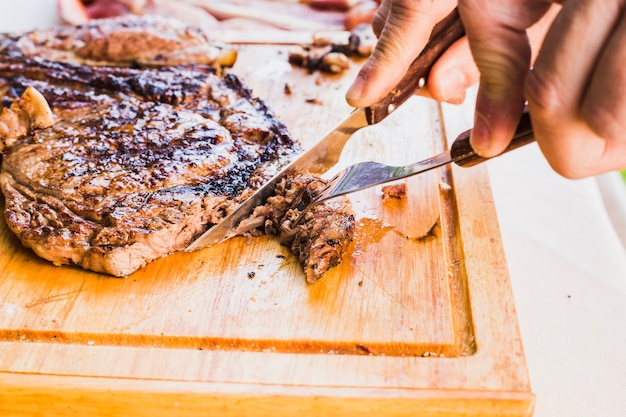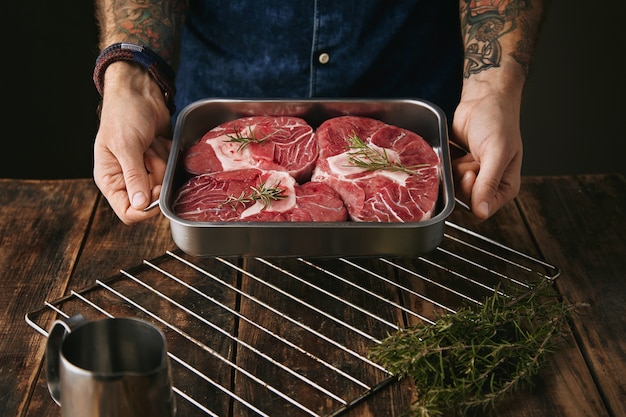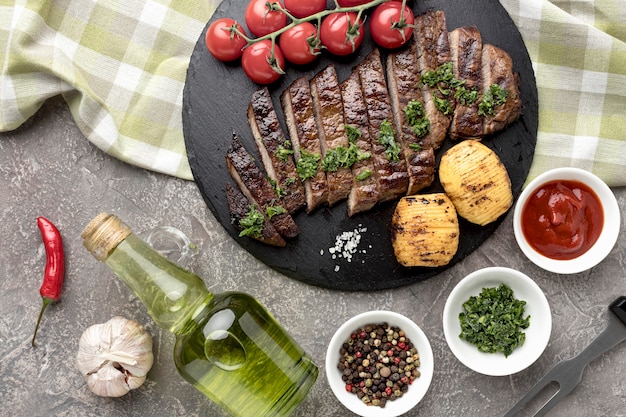(Part 1) choosing the right cut: Your Foundation of Flavour

Understanding the Rib-Eye Family
Rib-eye comes from the rib primal cut, the rib section of the cow. But within this primal, there are different sub-primal cuts, each with its own personality.- Bone-in Rib-Eye: This classic cut includes the bone, giving it a richer, more robust flavour. It's a true king of the table.
- Boneless Rib-Eye: A more convenient option for those who prefer a steak without the bone. It's a great choice for a more streamlined presentation.
- Cowboy Steak: This bone-in cut boasts a long, T-shaped bone, adding a visual wow factor and extra flavour. It's a statement piece for any meal.
- tomahawk steak: Another bone-in cut, this time with a long, bone-in handle that resembles a tomahawk. It's absolutely stunning on the plate, making a real impression.
Marbling Matters: The Key to Tenderness and Flavour
The marbling – those streaks of fat running through the muscle – is what truly defines a good rib-eye. It's what gives the steak that mouth-watering tenderness and rich, buttery flavour.You'll find rib-eye steaks graded based on marbling, with each grade representing a different level of flavour and tenderness:
| Grade | Description |
|---|---|
| Select | Least marbling, leaner and less flavourful. |
| Choice | Moderate marbling, a good balance of flavour and tenderness. |
| Prime | Most marbling, the ultimate in flavour and tenderness. |
While Select is a leaner option, it's still a good choice if you're looking for a less rich steak. Choice offers a good balance of flavour and fat, making it a popular choice. Prime is the king of rib-eyes, delivering intense flavour and melt-in-your-mouth tenderness. It's worth the splurge!
Thickness is Key: Choosing the Right Cook
Finally, think about the thickness of your steak. A thicker cut will take longer to cook and is best suited for grilling or roasting. Thinner cuts are ideal for quicker cooking methods like pan-searing.(Part 2) Getting Ready: Preparing Your Steak for Star Status

The Art of Seasoning: Enhancing the Natural Flavours
Rib-eye doesn't need a fancy orchestra of spices to sing. Simple is best. Salt and pepper are your best friends.My go-to method is to season liberally with salt and pepper about half an hour before cooking. This gives the salt time to penetrate the steak, drawing out moisture and intensifying flavour. But if you want to add a little extra punch, you can also sprinkle in a touch of garlic powder, onion powder, paprika, or a blend of herbs. Just be sure to keep it simple so you don't overwhelm the natural flavour of the steak.
Tempering the Steak: Bringing it to Room Temperature
Don't underestimate the importance of tempering! This simple step involves bringing your steak to room temperature before cooking. This ensures that the steak cooks evenly and you don't end up with a cold, undercooked centre.The Importance of Rest: Letting the Juices Redistribute
Once your steak is cooked, don't rush to cut into it. Let it rest for at least 5-10 minutes, covered with foil. This allows the juices to redistribute, making your steak more tender, juicy, and flavorful.(Part 3) Cooking Methods: Finding Your Perfect Technique

1. The Classic Grill: A Smoky and Charred Masterpiece
For me, grilling is the quintessential way to cook a rib-eye. That smoky flavour, those beautiful char marks – it's a classic for a reason.Getting Started: Preheating to Perfection
Start by preheating your grill to medium-high heat. You want the grill to be nice and hot so you can sear the steak quickly and create those impressive grill marks.The Sear: Creating a Crust of Flavour
Place the steak on the grill and cook for 2-3 minutes per side, making sure to rotate the steak by 90 degrees halfway through. This creates those coveted crosshatch grill marks that signal a perfectly seared steak.Cooking to Perfection: Achieving Your Desired Doneness
Once the steak is seared, move it to a cooler part of the grill or reduce the heat. Cook for another 2-4 minutes per side for medium-rare, or longer for a more well-done steak.2. The Cast Iron Powerhouse: Searing to Perfection
cast iron pans are fantastic for cooking steak. They get incredibly hot, giving you a beautiful sear and an evenly cooked steak.Searing to Perfection: The Hottest Pan in Town
Heat the cast iron pan over medium-high heat until it's smoking hot. You want it screaming hot! Add a tablespoon of oil to the pan and let it heat up. You'll know it's ready when it starts to shimmer.The Flip: Building a Beautiful Crust
Place the steak in the pan and cook for 2-3 minutes per side, creating a beautiful, crispy crust.Cooking to Your Preference: Achieving Your Desired Doneness
Once seared, reduce the heat to medium and cook for another 2-4 minutes per side for medium-rare, or longer for a well-done steak.3. The Oven's Embrace: A Controlled and Even Cook
For a more controlled and even cook, the oven is a fantastic option. It's a great choice for thicker steaks, ensuring that the heat reaches every part of the meat.Preheating and Seasoning: Setting the Stage for Success
Preheat your oven to 400°F (200°C). Season your steak liberally with salt and pepper.The Roast: Bringing Out the Best in Your Steak
Place the steak on a baking sheet and roast in the preheated oven for 10-12 minutes per side for medium-rare.Rest and Enjoy: A Moment of Bliss Before Digging In
Once cooked, let the steak rest for 10 minutes before slicing and serving.(Part 4) Temperature is King: Knowing Your Doneness
Doneness is a matter of personal preference, but there are a few ways to ensure your steak is cooked to your liking.internal temperature: The Most Accurate Method
The most accurate way to determine the doneness of your steak is by using a meat thermometer. Here's a general guideline for internal temperatures:- Rare: 125-130°F (52-54°C)
- Medium-Rare: 130-135°F (54-57°C)
- Medium: 135-140°F (57-60°C)
- Medium-Well: 140-145°F (60-63°C)
- Well Done: 145-150°F (63-65°C)
Visual Cues: A Helpful Guide for the Unprepared
If you don't have a thermometer, you can also use visual cues to estimate the doneness of your steak. Here's what to look for:- Rare: The centre of the steak will be red and cool to the touch.
- Medium-Rare: The centre of the steak will be pink, with a slight resistance to the touch.
- Medium: The centre of the steak will be pink and warm to the touch.
- Medium-Well: The centre of the steak will be slightly pink, with minimal resistance to the touch.
- Well Done: The centre of the steak will be brown and firm to the touch.
My Preference: A Matter of Taste
Personally, I prefer my rib-eye medium-rare. The steak is still juicy and tender, with a hint of pink in the centre. But, the most important thing is to cook the steak to your liking!(Part 5) Beyond the Basics: Advanced Techniques for the Experienced Cook
Now let's get a little more adventurous with some advanced techniques that will take your rib-eye game to the next level.reverse searing: For a Perfectly Even Cook
This technique involves cooking the steak slowly at a low temperature until it's almost fully cooked, then searing it to create a beautiful crust. It's a great way to ensure an evenly cooked steak, especially for thicker cuts.For reverse searing, place the steak in a preheated oven at 250°F (120°C) for about 1-1.5 hours, until it reaches an internal temperature of about 115°F (46°C) for medium-rare. Then, sear the steak over high heat for 2-3 minutes per side to create a crispy crust.
Sous Vide: A Precise Cook for the Perfectionist
This technique involves cooking the steak in a water bath, which ensures perfectly even cooking throughout. It's a great choice for those who want to achieve a specific internal temperature with precision.Sous vide requires a water bath set to the desired internal temperature. You'll need a vacuum sealer to seal the steak in a bag and then immerse it in the water bath for the recommended time. Once cooked, you can sear the steak to create a crispy crust.
(Part 6) Sides that Shine: Pairing with Perfection
What's a king without a royal court? You need the right side dishes to complement your perfectly cooked rib-eye.Classic Combinations: A Time-Honored Pairing
- mashed potatoes: Creamy and comforting, mashed potatoes are a timeless pairing for steak.
- Roasted Vegetables: roasted asparagus, broccoli, or Brussels sprouts add a delightful crunch and flavour.
- Green Salad: A refreshing green salad with a vinaigrette dressing balances out the richness of the steak.
Elevated Options: Taking Things to the Next Level
- asparagus with lemon and parmesan: The bright acidity of lemon and the richness of Parmesan complement the steak beautifully.
- Roasted Garlic and Herb Potatoes: These potatoes are packed with flavour and add a wonderful aromatic dimension to the dish.
- Creamed Spinach: This creamy and decadent side dish adds a touch of luxury to your steak dinner.
My Go-to: Roasted Garlic and Herb Potatoes
For me, roasted garlic and herb potatoes are the perfect side dish for a rib-eye. The potatoes are roasted to perfection, with a crispy exterior and a fluffy interior, and the garlic and herbs add a beautiful flavour.(Part 7) The Final Touch: Sauces and Garnishes
Just like a crown atop a king's head, a sauce or garnish can elevate your rib-eye to new heights.Classic Sauce Options: Enhancing the Flavour
- Béarnaise Sauce: This creamy, tangy sauce is a classic pairing for steak.
- Red Wine Sauce: A rich and robust sauce that complements the flavour of the steak.
- Peppercorn Sauce: A spicy and flavourful sauce that adds a kick to your steak.
Garnishing with Finesse: A Touch of Elegance
- Fresh Herbs: A sprig of rosemary, thyme, or parsley adds a touch of freshness and colour.
- Lemon Wedges: A squeeze of lemon juice adds a bright acidity to the steak.
- Aioli: A creamy garlic sauce that adds a delicious flavour and texture to the steak.
My Pick: Béarnaise Sauce
I love the classic combination of rib-eye with Béarnaise sauce. The creamy, tangy sauce complements the richness of the steak perfectly.(Part 8) FAQs: The Answers You Need
1. How do I tell if a rib-eye steak is fresh?
Look for a bright red colour, firm texture, and a slightly marbled appearance. Avoid steaks that are discoloured, slimy, or have an off smell.
2. What’s the best way to store a rib-eye steak?
For best results, store your rib-eye in the refrigerator, wrapped tightly in plastic wrap or stored in an airtight container. You can also freeze rib-eye steak for up to 3-4 months. When freezing, wrap the steak tightly in plastic wrap and then in aluminum foil.
3. What are some good wine pairings for rib-eye steak?
A full-bodied red wine, such as Cabernet Sauvignon, Merlot, or Shiraz, is a classic pairing for rib-eye steak. However, a light-bodied red wine, such as Pinot Noir, or a crisp white wine, such as Sauvignon Blanc, can also be enjoyable pairings. The best pairing will depend on your personal preference and the specific flavours of the steak and side dishes.
4. How do I prevent my rib-eye steak from drying out?
Avoid overcooking your steak. Use a meat thermometer to ensure that the steak is cooked to your desired doneness. Allow the steak to rest for 5-10 minutes before slicing and serving. This will allow the juices to redistribute, resulting in a more tender and juicy steak.
5. Can I cook a rib-eye steak on the stovetop?
Absolutely! Use a cast iron pan or a heavy-bottomed skillet and follow the same steps as described in the “Cast Iron Powerhouse” section. Just ensure your pan is nice and hot before adding the steak.
There you have it! Now you're ready to conquer the world of rib-eye steak. Go forth, experiment, and enjoy the journey! Remember, the most important thing is to cook the steak to your liking and to have fun in the kitchen!
Everyone is watching

Corn on the Cob: The Ultimate Guide to Perfectly Cooked Ears
Healthy MealsAh, corn on the cob. Just the name evokes images of sunny days, barbecues, and that sweet, juicy flavour that ...

Perfect Pork Roast Oven Cooking Time: A Guide to Delicious Results
Healthy MealsThere's something truly satisfying about a perfectly roasted pork. The aroma alone is enough to make your mout...

Ham Cooking Time: How Long to Bake, Smoke, or Boil a Delicious Ham
Healthy MealsAh, ham. It's a classic, isn't it? A real crowd-pleaser, especially around holidays. And when done right, it'...

Scallops: The Ultimate Guide to Perfect Cooking
Healthy MealsAh, scallops. Those delicate, sweet, and utterly delicious morsels of the sea. They hold a special place in my...

Spaghetti Squash: The Ultimate Guide to Cooking and Serving
Healthy MealsRemember that time you saw spaghetti squash at the supermarket, looking all bumpy and strange, and thought, "W...
